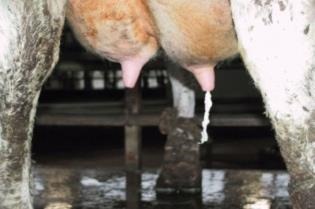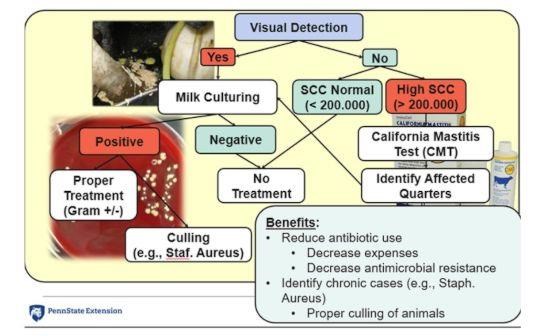By ADRIAN A BARRAGAN
Preventing mastitis could be achieved by simple farm practices rooted in understanding the main disease risk factors and focusing on addressing them. With that being said, we need to dive into a little foundational knowledge regarding this prevalent and costly disease. Mastitis initially can be classified as clinical or subclinical based on the presence or absence of clinical signs. Abnormal milk is the most common clinical sign. Both clinical and subclinical mastitis are associated with lower milk production, and subsequently, impaired farm profitability. Another classification that encompasses both clinical and subclinical mastitis is based on the pathogen causing the disease. This classification groups mastitis cases into environmental or contagious. The first type, environmental mastitis, is caused by pathogens that live in the environment and the disease is transmitted by direct contact of the udder with surfaces where these pathogens live such as the bedding or manure. The second type, contagious mastitis, is caused by pathogens that live in the udder and their only mechanisms of transmission is by being carried from one quarter to another or from one udder to another by some external factor, like the milker’s hand.

For mastitis, as well as for other diseases, a management program should consist of the following main components: prevention, monitoring, and troubleshooting. The prevention component should be aimed at addressing the main risk factors for mastitis. Regardless of the type of mastitis, there are three main farm management goals:
- protecting udder natural defense mechanisms,
- minimizing udder residual milk after milking, and
- decreasing udder pathogen exposure.
The main natural defense mechanisms that the udder has to prevent the entrance of pathogens are anatomical structures in the teat canal (such as mucosa folds [Furstenberg’s Rosette] and the teat sphincter) and the physical swiping effect of milk coming out of the gland. All these mechanisms are aimed at naturally preventing pathogens entrance to the gland. For the second goal, minimizing udder residual milk after milking is important because when the udder is not properly milked out after each milking, it fills up sooner, and the risk of leaking milk in the pen increases. When leaking milk, the teat canal opens while the udder can be potentially exposed to pathogens, such as when the cow is lying down in the stall with her udder touching a manure pile. Last but not least, the third goal, decreasing udder pathogen exposure, includes perhaps some of the most important practices to prevent mastitis. Proper pre-dipping, ensuring that the total teat skin is covered to the base while allowing enough time for the pre-dipping solution to kill the pathogens, and dry wiping dirty teats are some of the recommended practices in the parlor to decrease udder pathogen exposure. Other practices such as changing gloves after milking mastitic quarters and proper post-dipping are similarly important as well. Also, daily pen management practices, such as proper alley cleaning with frequent removal of wet bedding and manure between milkings are extremely beneficial at decreasing exposure to pathogens. Likewise, it is worth mentioning the great importance of proper personnel training for ensuring excellent implementation of these management practices.
Monitoring disease incidence is critical to address issues in a timely manner. As mentioned above, there are different forms of mastitis, and all of them must be monitored to identify the areas that must be improved. For instance, if issues with contagious mastitis arise, the first thing to investigate are milking practices and the proper operation of the milking parlor. When issues with environmental mastitis arise, pen management practices must be assessed for areas of improvement.
The final step of a successful management program should begin with a troubleshooting approach. To start with, the monitoring component discussed above is critical for effectively troubleshooting mastitis issues. As a first step, identifying the type of mastitis you are dealing with is critical for finding the root cause and, addressing it in a timely manner to prevent further losses. For this component, the quality and quantity of farm records should be a priority. There are two main scenarios when it comes to improper record-keeping practices are not having the records or having inaccurate records. With these two scenarios, no records are preferred to inaccurate records, because no decisions are made with no records. On the other hand, decisions made with inaccurate records are likely to be wrong. Records such as individual cow somatic cell counts, the incidence of clinical mastitis (including the type of mastitis [environmental vs contagious]), and trends for disease incidence are useful information to troubleshoot mastitis issues. Figure 1 displays a troubleshooting diagram that can be used to manage mastitis in dairy farms. This diagram shows the different steps needed to identify the actual pathogens causing the mastitis issues and different management options depending on diagnosis results.

Figure 1. Decision making diagram for troubleshooting mastitis in dairy farms
Although prevalent and costly, mastitis can be prevented by implementing simple farm practices. Knowledge regarding disease causing agents is critical to understand farm areas to monitor and control. A mastitis farm management program should include prevention, monitoring, and troubleshooting components. Milking and pen management practices are some of the most important areas to prevent mastitis, and personnel training is key to ensuring proper implementation of these practices. Monitoring different parameters of the disease, such as disease incidence (including the type of mastitis) and disease trends (e.g., mastitis incidence by milking shift), is critical to accurately identify the root causes so they can be addressed in a timely manner. When troubleshooting mastitis, records quantity and quality are crucial to timely and accurately troubleshoot mastitis in dairy farms.
Source : psu.edu